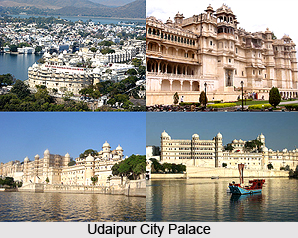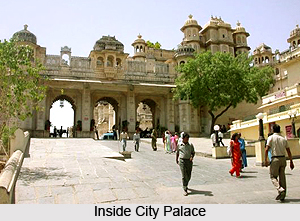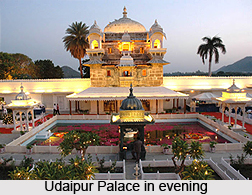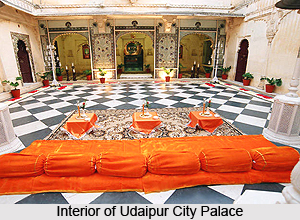 Built on the banks of Lake Pichola, the foundations of the City Palace Complex, Udaipur was laid by Maharana Udai Singhji when he decided to build a new capital for the Sisodia rulers of Chittorgarh, Rajasthan. Subsequent Maharanas later extended it to its present form, by adding several palaces and structures to the complex and yet retaining a surprising uniformity to the design. The palace is made of granite and marble and is built on a raised height and surrounded by crenellated fort walls.
Built on the banks of Lake Pichola, the foundations of the City Palace Complex, Udaipur was laid by Maharana Udai Singhji when he decided to build a new capital for the Sisodia rulers of Chittorgarh, Rajasthan. Subsequent Maharanas later extended it to its present form, by adding several palaces and structures to the complex and yet retaining a surprising uniformity to the design. The palace is made of granite and marble and is built on a raised height and surrounded by crenellated fort walls.
This palace is now a heritage building, showcasing the elements of Rajput culture and the arts. It also combines the elements of Chinese and European architecture and has a number of remarkable buildings of immense beauty, gardens and fountains, well planned and finely executed over the years. Also in the palace, there is the range of turrets, domes and arches to form a fascinating sight with the aesthetic beauty of their artwork.
The City Palace Complex is essentially a fortified city with massive walls enclosing a mini township within its folds. There are several gigantic gateways that lead to the City Palace Complex. But the famous entrance to the Palace complex is through the `Elephant Gate` or the `Hathi Pol` from the main road. Among the other gateways the Bara Pol and Tripolia Pol were significant in the olden days.

The biggest and most beautiful temple of Udaipur, the Jagdish Temple (1651A.D), where Lord Vishnu is worshipped can be seen here. The `Great Gate` or `Bara Pol` (1600A.D) on the northern end is the entrance to the first courtyard, which joins Tripolia or the `Triple Gate` (1725 A.D). There are eight carved marble arches or `Toranas`, between the two gates, under which the Maharanas would weigh themselves under this gate in gold and silver, and the value of their weight would in turn be distributed to the populace. It is also now the main ticket office.
Beyond the Tripolia there is an arena of marble arches, where various elephants were staged, since it was an elephant-fighting arena. There are also many gardens within the palace complex. The City Palace museum is then entered through the Ganesh Deori meaning the door of Lord Ganesh, which leads to the oldest part of the palace, `Raj Aangan` (Royal Courtyard-1571) which Maharana Udai Singh built in the 16th century. This is the very spot where Maharana Udai Singh met the sage who told him to find a city here. Its main part, along with its several Mahals is now preserved as a Museum that displays a large and diverse array of artifacts. Down from the entrance of the museum, is the armory museum exhibiting a huge collection of protective gear, weapons including the lethal two-pronged sword.
The Krishna Vilas has a rich and remarkable collection of miniature paintings depicting royal processions, festivals and games of the Maharanas.
The Mor Chowk is the peacock square and gains its name since unique glass mosaics of peacocks set in the wall, decorate it showing the three seasons: summer, winter and monsoon.
The Manak Mahal (Ruby Palace) has a lovely collection of glass & mirror work. It also has crystal and porcelain figures.
Bhim Vilas with Radha Krishna stories painted on the walls has a glass mosaic gallery, the `Suraj Gokhala`, with beautiful stained glasses and a panoramic view of the city below.

The Zenana Mahal, the queen`s quarters to the south and the `Dilkusha Mahal` (Palace of Joy) have frescoes and wall paintings and it leads to Lakshmi Chowk a beautiful white pavilion.
The Laxmi Vilas Chowk, an art gallery, houses a distinctive collection of Mewar paintings.
The Chini Chitrashala is famous for its Chinese and Dutch ornamental tiles, the latter of which has depiction of Biblical scenes including the flight to Egypt.
The Moti Mahal (Palace of Pearls) has lavish and beautiful mirror decor and the Sheesh Mahal (Palace of mirrors) has inlaid mirror work.
There is a Hawa Mahal and a Bari Mahal, which is a central garden with view of the city with a fine garden build on a 90 feet high natural rock formation.
The Amar Vilas, the highest point has exquisite hanging gardens with fountains, towers and terraces and a majestic view of the town and Lake Pichola.
 The Suraj Gokhada or the balcony of the sun is where the Maharana would grant public audiences mainly to boost the morale of the people in difficult times.
The Suraj Gokhada or the balcony of the sun is where the Maharana would grant public audiences mainly to boost the morale of the people in difficult times.
The palaces of Dilkhush mahal, Sheesh mahal, Moti mahal and Krishna vilas- were built in memory of a princess of striking beauty who poisoned herself to avert bloody battle for her hand by rival princess. Now the palace is housed with many antique articles, paintings, decorative furniture and utensils, which attracts thousands of visitors every day. Inside the separate palace enclosure, entered from the South of Badi Chowk, there are also the Shiv Niwas and Fateh Prakash Palace, which are now run as hotels.




